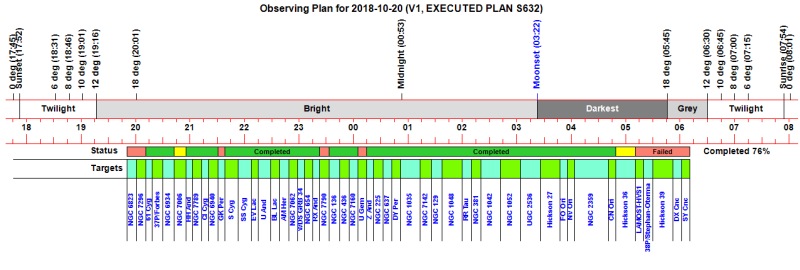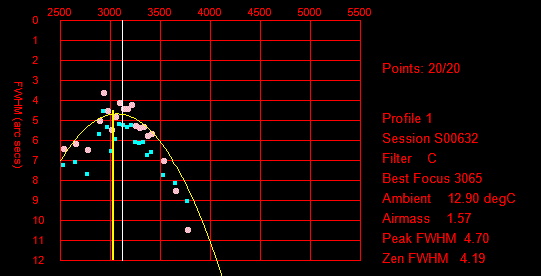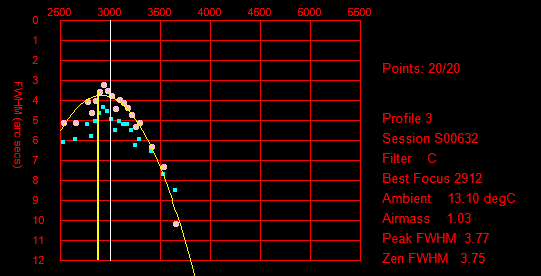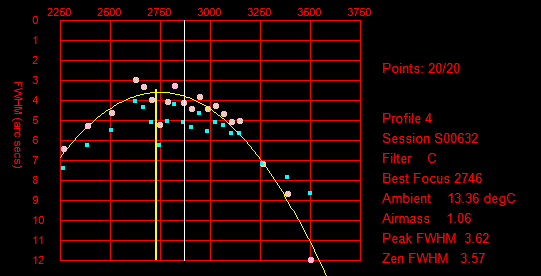David's Astronomy Pages
Notes - Session 632 (2018-10-20)
Notes
(S631)
Notes
Main
Home
Page
Notes
(S633)
David's Astronomy Pages
|
Notes (S631) |
Notes Main |
Home Page |
Notes (S633) |
| Session Aims & Highlights | |
|
- Observing Result - Night Summary Plot |
|
| Operational Issues | |
|
- Critical Issues (0),
Major Issues (0),
Minor Issues (2),
Continuous Improvement (1) |
|
| Autofocussing | |
 |
Images from 2018-10-20 >> |
| New Equipment Review - Dew Controller, Motor Focus & Mount Hub (2018-10-20) | |
| Cabling Review - TCF-S Focuser Control (2018-10-20) | |
| New Equipment - Way Forward (2018-10-26) | |
Main aims
Equipment & Software
Highlights
Summary Plots & Logs
|
Observing Result (2018-10-20, S632) Observatory Ops began 19:46. Session started 19:57, Job queue started at 20:02 (12 min after Planned Start) Focussing runs at 20:27 (5 mins) 22:04 (5 min), 23:13 (4 mins). Session suspended at 04:50 due to critical cloud (70 mins) Job queue ended at 06:01. Observatory closed 06:02. Session finished at 06:03 |
 |
| (Observation Status : Green=Completed, Yellow= Partially Completed, Red= Failed) |
|
Night Sky Summary Plot -
2018-10-20 Top axis: Sky Brightness at Zenith (in ADU/s) Lefthand axis: Local Time (hh LT). Righthand axis: Sun Altitude (degs) |
 |
Back to Top
Back to Top
Three Focus profiles during session (including HFD measurements).
| Focus Profiles, including new HFD measurements |
 |
 |
 |
Back to Top
To continue progress towards automated / unattended operation of the Clair3
Observatory the following new equipment is required :
- a
computer connected focus controller for focusing the TS 80mm
APO secondary scope using a connected stepper motor.
- a focus stepper
motor with gearbox (connected to the TS 80mm APO secondary scope
and operated via the focus controller)
- a computer
connected dew controller capable of regulated dew heater control based on dew
point & capable of being completely switched off during the daytime.
The functionality could be provided by standalone equipment with independant
12V power and USB cables going to the scope (Option 1 below). However
since there are several Mount Hubs (Options 2,3 & 4 below) that are
available that offer both dew hearter control and focus controller, as well as
other potential useful features such as a USB Hub, multiple 12V power ports
served by Single Power Cable connection to the Mount. It is therefore
appropriate that the new equipment review
also considers
-
a computer connected Mount Power / USB hub
A USB connected dew controller (replacing the existing manual controlled dew controller) and a USB connected focus controller (+ its 12 V power supply) would add 3 additional cables going to the telescope compared to the existing setup. Instead of requiring extra cables a Mount Hub has the potential to reduce the overall number of cables going to the scope. Furthermore a Mount Hub provides the opportunity to mount additional equipment to the scope without requiring any additional cabling to the scope (equipment such as a web cam, proximity sensor, arduino based sensor).
Issues which might limit the benefits of a Mount Hub, are that
- the
SBIG ST-10 CCD Camera uses a special AC/DC adapter which powers a special 12v +
5.5v DC cable connection to the camera
(it may be difficult to provide
this power connection from 2 x 12v Mount Hub Ports without some specialist
electrical support)
- the The Focus Controller box for TCF-S focuser uses a RS-232 style
of cable connection to a Serial /USB adapter housed near the computer.
(although
the controller box is quite large it should be feasible to fix it to the scope
and move the Serial/USB adapter onto the scope)
- 12V power to LX200 Scope is
provided via a cable from the pier and wouldn't benefit mechanically from being
powered from the Mount Hub. Turning the LX200 Scope off/on however using the Hub
would be potential benefit (provided that power continued to flow if the
Powerbox was rebooted during the session)
The principle options are
1) Standalone dew heater controller and focus controller + Stepper Motor (no Mount Hub)
Two motor focus options that are specifically recommended for my TS 80mm APO
telescope (2.5" RAP) on the telescope's
product page on the TS website. They are 'USB Focu's and the 'PrimaLuce
SestoSenso'. Other motor focusers should have also work with the scope RAP
focuser.
1A.a) USB Focus V3 motor focuser (USB Focus,
France)
http://www.usb-foc.us/shop/product/usb-focus-heavy-set-2
https://www.teleskop-express.de/shop/product_info.php/info/p8501_USB-Focus-adapter-kit-for-2-5--and-3--R-P-focusers.html
USB_Focus v3 Set (Controller, temperature sensor, stepper motor ).
Control box includes manual in/out buttons
Two versions, standard (up to 1.5 kg payload, 8V or USB powered), and strong
motor (up to <4.5 kg payload, 12 V). The strong motor version is
considered more suitable because of its greater payload limit and because its
12V supply provides an upgrade path to using it with a Mount Hub at a future
date.
Cost £280 for standard version from TS, Germany (217
EUR for USB_Focus Set (1.5 kg) + 100 EUR for BR-FOCR25 Adapter kit ), excl
14 EUR shipping
Cost £368 for stronger version from TS, Germany
(318 EUR for USB_Focus Set (4.5kg) + 100 EUR for BR-FOCR25 Adapter kit), excl 14
EUR shipping
1A.b) SestoSenso motor focuser
(PrimaLuceLab, Italy)
https://www.primalucelab.com/astronomy/focusers/sesto-senso-robotic-focusing-motor.html
All-In-One Unit (Controller/Motor) with ASCOM Driver
Drawbacks USB Mini, 12V supply required, Sensor is extra. Fits on
the fine focusing shaft.. No manual control option.
Cost £430 from TS, Germany (367 EUR for SestoSenso + 76 EUR for 33mm Shaft Adapter + 45 EUR Temperature Probe), excl 14 EUR shipping
1A.c) Pegasus FocusCube universal motor focus
(PegasusAstro, Greece)
https://pegasusastro.com/products/focuscube/
All-In-One Unit (Controller/Motor) with ASCOM Driver
Fits
on the fine focusing shaft.. No manual control option.
Cost £225 from AltairAstro, UK , excl shipping
1B.a) USB Dew Point V2 dew heater controller (USB_Focus,
France)
http://www.usb-foc.us/shop/product/usb-dewpoint-v2-11
3 12v output ports. Includes 1 Humidity Sensor & 2
independant Temperature Sensors
Can perform fully automonous regulated dew
heater control
Cost £246 from TS, Germany (279 EUR for USB
DewPoint v2), excl 14 EUR shipping
Total Cost £471 for Standalone Option (£225 for standalone Pegasus Focus Cube + £246 for standalone USB Dew Point V2)
2) HitecAstro Mount Hub Pro V4 + Stepper Motor
https://www.hitecastro.co.uk/index.php/products/item/mount-hub-pro-v4
Key features:
- Power managment and sensing with 4x12V outputs,
- Dew
control - three outputs, independently controlled.
- Stepper Motor Focus
controller with temperature compensation. (Separate 3rd party motor required).
- 6
port USB2.0 hub
- 1 Temperature Sensor Probe
- ASCOM drivers for
Focus Control only
- No updated API for operating Heaters/Relay (as at Oct
2018)
. No manual (as at Oct 2018)
Cost £594 to £614 (£499 for Ultimate Powerbox from
365Astronomy UK, £115 for Focus
Motor: PEG-MF3-MOTOR-UN from AltairAstro UK)
(£ 479 for Ultimate Powerbox from RotherValleyOptics UK
3) PegasusAstro Ultimate Powerbox
https://pegasusastro.com/products/ultimate-powerbox/
Key features:
- Power managment and sensing with 4x12V Smart outputs,
- Dew
control - two outputs, independently controlled.
- Stepper Motor Focus
controller with temperature compensation. (Motors available separately).
- 6
port USB2.0** hub with 3A power and remote control switching.
- Environmental
sensing.
- Full remote automation and software control.
- 380g /
130x100x30mm.
- ASCOM drivers for Focus Control, Enviromental Sensors
(UDP port control of Heaters)
Cost £665 ( £550 for Ultimate Powerbox, £115
for Focus
Motor: PEG-MF3-MOTOR-UN from AltairAstro UK)
+ £xx for 12V, 10A Power Supply (eg.
https://pegasusastro.com/products/power-supply/)
4) PrimaLuce Eagle 2 + Focus Controller/Stepper
Motor
https://www.primalucelab.com/astronomy/eagle-control-unit-for-telescopes-and-astrophotography.html
Key features:
- 3 x 0-12V ports for dew heaters etc
- 4 x 12v power out
ports (for camera, mounts etc)
- 4 USB 3.0 ports
- 4 USB 2.0 ports
-
WIFI & Ethernet Connectivity
- Remote on/off, Eagle Manager, Power
Bridge
- i3 processor, 8 GB RAM, 120 GB SSD disk
- Windows 10 Enterprise
- 1.2 Kg
The Eagle 2 doesn't include a Focus Controller so one needs to get SestoSenso or something like the Pegasus FocusCube or USB Focus V3
Cost £ 1,774 (£1,344.00 for Eagle 2 from WideScreen-Center UK + £430 from SestoSenso from TS, Germany (367 EUR for SestoSenso + 76 EUR for 33mm Shaft Adapter + 45 EUR Temperature Probe)
Conclusion.
Based on overall features, fit to
requirements, and opportunity to reduce cabling & add possible future
accessories Option 3, the PegasusAstro Ultimate Powerbox
+ MF3-MOTOR-UN, is selected pending answers to a few
outstanding questions from the PegasusAstro team.
Option 1 (standalone Motor Focuser and Dew Heater Controller) is the cheapest
option but requires additional cabling to the scope and provides no option for
adding additional accessories or for reducing cabling going to the scope.
Option 2 (HitecAstro Mount Pro V4 + Stepper Motor) is rejected. Although
competitively priced with good overall features and, like PegasusAstro's
Powerbox, has opportunity to reduce cabling etc, its associated software
including ASCOM / API are less mature or still in development as at Oct 2018.
Option 4 (Eagle 2) is rejected as being too expensive with onboard computing
that is unrequired for my permanent observatory setup which already has computer
resources.
Back to Top
Supplementary to a new equipment review for Dew Heater, Motor Focus & Mount Hub, the cabling for the existing TCF-S Focuser is also being reviewed.
Currently the TCF-S focuser control box is loosely attached to the pier, with a 12V power cable going to an AC/DC Adapter in the Observatory Bay 2 and an RJ-12 & flat 'Reverse' Serial Cable going to a Serial Port Converter - RJ12 (female) to DB-9 (female) in the Observatory Bay 2 which is connected to a Keyspan Serial-USB Adapter and then via a USB cable to a USB Hub connected to the Observatory Computer. A 6ft long control cable (eight wire - four twisted pair) connects the control box to the TCF-S focuser on the telescope (via RJ-45 connector on one end and a 9-pin sub-D connector on the other).
The 3-piece communication wiring scheme using a 'reverse' serial cable is less than optimal but was the method used by Optec for many years. Recent advancements in USB-to-Serial converter technologies has allowed Optec to now offer new Serial Cables with Integrated USB Converters in place of the former 3-piece configuration. Cables are available from Optec in standard lengths of 6, 12, 25, and 50-ft, or in custom lengths.
Problems having been encountered with loosing connection to the TCF-S focuser part way through an observing session (eg. session on 2018-10-21), Whilst occasional, the problem is particularly anyoying when it occurs and is a show-stopper for reliable unattended operation of the observatory. There may be an opportunity to improve the USB to serial connection reliability using new cabling.
With the proposal to purchase a Pegasus Ultimate Powerbox/Hub (with 12V and USB ports) there is opportunity to reduce the cabling going to scope, by potentially connecting the TCF-S control box to the Powerbox/Hub.
The principle options are
1) Do nothing - use existing cable arrangement and cables
- Cheapest option (No monetary cost)
- No opportunity to resolve 'lost
focuser connection' problem
- No reduction in the cabling going to the
scope.
- Almost certain continuation of the 'lost focuser connection'
problem
2) Keep existing arrangement, but replace
existing 3 piece communication wiring by a new serial-USB cable
- Might solve the 'lost focuser connection' problem (but no guarentee),
- No reduction in the cabling going to the scope.
Cost
£47 ($60 for a 12ft new Serial/USB cable from Optec, USA), excludes
shipping & duty
3) Relocate the Focuser
Control Box to position next to the Observatory Computer (Observatory Bay 2)
- Contol box positioned next to computer in Observatory Bay 2 with just one
cable (a new 12ft control cable) going to the scope/pier instead of 3 existing
cables
(need to check if a 12 ft cable length is sufficient, the next
standard length is 25ft ))
https://optecinc.com/astronomy/catalog/cables/control_cables.htm
-
Existing 3 piece communication wiring replaced by a 6ft new serial-USB cable
https://optecinc.com/astronomy/catalog/cables/serial_cables.htm
-
Partial reduction in overall cabling going to scope.
- Might solve the 'lost
focuser connection' problem (but no guarentee)
Cost £74 ($40 for a 12ft Control Cable + $55 for a 6ft new Serial/USB cable from Optec, USA), excludes shipping & duty
4) Mount the Focuser Control Box on the
Scope itself and connect via PowerBox/Hub
- Contol box
mounted on the scope itself in someway and connected to PowerBox/Hub (also
attached to Scope)
- Mounting the Control Box is likely to be clumsey (its
quite big) and the manual buttons will be less accessible
- Significant
reduction in cabling going to scope (but extra cabling on the scope itself)
- Might solve the 'lost focuser connection' problem (but no guarentee)
- Cost
is relatively small assuming just a new Serial-USB cable
(cabling
could be optimised by using a custom 3ft new Serial /USB cable and a custom 3ft
Control Cable
- not sure what the additional charge is for
customised lengths)
Cost £43 ($55 for for 6ft new Serial/USB cable from Optec, USA), excludes shipping & duty
4) Mount the Focuser Control Box on the
Scope itself and connect via PowerBox/Hub
- Contol box
mounted on the scope itself in someway and connected to PowerBox/Hub (also
attached to Scope)
- Mounting the Control Box is likely to be clumsey (its
quite big) and the manual buttons will be less accessible
- Significant
reduction in cabling going to scope (but extra cabling on the scope itself)
- Might solve the 'lost focuser connection' problem (but no guarentee)
- Cost
is relatively small assuming just a new Serial-USB cable
(cabling
could be optimised by using a custom 3ft new Serial /USB cable and a custom 3ft
Control Cable
- not sure what the additional charge is for
customised lengths)
Cost £43 ($55 for for 6ft new Serial/USB cable from Optec, USA), excludes shipping & duty
5) Upgrade Focuser to theTCF-Si focuser
with integrated controller (removing the bulky Control Box)
https://optecinc.com/astronomy/catalog/tcf/17668.htm
- New TCF-S model with integrated controller (it doesn't
use the bulky Control Box used by the original TCF-S model)
- Comes with a
6ft Serial-USB cable (assume this is a new integrated serial-USB cable)
- Might solve the 'lost focuser connection' problem (but no guarentee)
- Cost
is very large just for getting an integrated controller, when the existing
Focuser with Control Box works ok
- Can't seem to find a dealer offering the
TCF-Si in Europe (Only the older TCF-S model are shown on websiste and for 1217
EUR from TS, Germany)
Cost £562 (x2) ($725 for TFC-Si from OptCorp, USA), excludes shipping & duty ( more like £1200-1300 after including shipping/duty)
Conclusion.
Based on their potential benefits Option 3,
(Relocate the Focuser Control Box to a position next to the Observatory
Computer), and Option 4 (Mount the Focuser Control Box on the
Scope itself and connect via PowerBox/Hub) are the two best options.
Option 1 (Do Nothing) is rejected as it offers no improvement on the current
situation.
Option 2 (Keep existing arrangement, but replace existing 3
piece communication wiring by a new serial-USB cable) is a possible but less
preferred option.
Option 5 (TCF-Si focuser with integrated controller) is
rejected based on Cost.
Back to Top
- Query Hitect Mount Hub detail with HitecAstro - Done
- Query Ultimate
PowerBox detail with PegasusAstro - Done
- Order new USB Hub - Done
(LINDY USB Hub - 7 Port Industrial USB 2.0 Hub Metal )
- Download Ultimate Powerbox standalone program from PegasusAstro- Done (Version 1.4.7.0)
Supplementary to a new equipment review for Dew Heater, Motor Focus & Mount Hub, the cabling for the existing TCF-S Focuser is also being reviewed.
Currently the TCF-S focuser control box is loosely attached to the pier, with a 12V power cable going to an AC/DC Adapter in the Observatory Bay 2 and an RJ-12 & flat 'Reverse' Serial Cable going to a Serial Port Converter - RJ12 (female) to DB-9 (female) in the Observatory Bay 2 which is connected to a Keyspan Serial-USB Adapter and then via a USB cable to a USB Hub connected to the Observatory Computer. A 6ft long control cable (eight wire - four twisted pair) connects the control box to the TCF-S focuser on the telescope (via RJ-45 connector on one end and a 9-pin sub-D connector on the other).
The 3-piece communication wiring scheme using a 'reverse' serial cable is less than optimal but was the method used by Optec for many years. Recent advancements in USB-to-Serial converter technologies has allowed Optec to now offer new Serial Cables with Integrated USB Converters in place of the former 3-piece configuration. Cables are available from Optec in standard lengths of 6, 12, 25, and 50-ft, or in custom lengths.
Problems having been encountered with loosing connection to the TCF-S focuser part way through an observing session (eg. session on 2018-10-21), Whilst occasional, the problem is particularly anyoying when it occurs and is a show-stopper for reliable unattended operation of the observatory. There may be an opportunity to improve the USB to serial connection reliability using new cabling.
With the proposal to purchase a Pegasus Ultimate Powerbox/Hub (with 12V and USB ports) there is opportunity to reduce the cabling going to scope, by potentially connecting the TCF-S control box to the Powerbox/Hub.
The principle options are
1) Do nothing - use existing cable arrangement and cables
- Cheapest option (No monetary cost)
- No opportunity to resolve 'lost
focuser connection' problem
- No reduction in the cabling going to the
scope.
- Almost certain continuation of the 'lost focuser connection'
problem
2) Keep existing arrangement, but replace
existing 3 piece communication wiring by a new serial-USB cable
- Might solve the 'lost focuser connection' problem (but no guarentee),
- No reduction in the cabling going to the scope.
Cost
£47 ($60 for a 12ft new Serial/USB cable from Optec, USA), excludes
shipping & duty
3) Relocate the Focuser
Control Box to position next to the Observatory Computer (Observatory Bay 2)
- Contol box positioned next to computer in Observatory Bay 2 with just one
cable (a new 12ft control cable) going to the scope/pier instead of 3 existing
cables
(need to check if a 12 ft cable length is sufficient, the next
standard length is 25ft ))
https://optecinc.com/astronomy/catalog/cables/control_cables.htm
-
Existing 3 piece communication wiring replaced by a 6ft new serial-USB cable
https://optecinc.com/astronomy/catalog/cables/serial_cables.htm
-
Partial reduction in overall cabling going to scope.
- Might solve the 'lost
focuser connection' problem (but no guarentee)
Cost £74 ($40 for a 12ft Control Cable + $55 for a 6ft new Serial/USB cable from Optec, USA), excludes shipping & duty
4) Mount the Focuser Control Box on the
Scope itself and connect via PowerBox/Hub
- Contol box
mounted on the scope itself in someway and connected to PowerBox/Hub (also
attached to Scope)
- Mounting the Control Box is likely to be clumsey (its
quite big) and the manual buttons will be less accessible
- Significant
reduction in cabling going to scope (but extra cabling on the scope itself)
- Might solve the 'lost focuser connection' problem (but no guarentee)
- Cost
is relatively small assuming just a new Serial-USB cable
(cabling
could be optimised by using a custom 3ft new Serial /USB cable and a custom 3ft
Control Cable
- not sure what the additional charge is for
customised lengths)
Cost £43 ($55 for for 6ft new Serial/USB cable from Optec, USA), excludes shipping & duty
4) Mount the Focuser Control Box on the
Scope itself and connect via PowerBox/Hub
- Contol box
mounted on the scope itself in someway and connected to PowerBox/Hub (also
attached to Scope)
- Mounting the Control Box is likely to be clumsey (its
quite big) and the manual buttons will be less accessible
- Significant
reduction in cabling going to scope (but extra cabling on the scope itself)
- Might solve the 'lost focuser connection' problem (but no guarentee)
- Cost
is relatively small assuming just a new Serial-USB cable
(cabling
could be optimised by using a custom 3ft new Serial /USB cable and a custom 3ft
Control Cable
- not sure what the additional charge is for
customised lengths)
Cost £43 ($55 for for 6ft new Serial/USB cable from Optec, USA), excludes shipping & duty
5) Upgrade Focuser to theTCF-Si focuser
with integrated controller (removing the bulky Control Box)
https://optecinc.com/astronomy/catalog/tcf/17668.htm
- New TCF-S model with integrated controller (it doesn't
use the bulky Control Box used by the original TCF-S model)
- Comes with a
6ft Serial-USB cable (assume this is a new integrated serial-USB cable)
- Might solve the 'lost focuser connection' problem (but no guarentee)
- Cost
is very large just for getting an integrated controller, when the existing
Focuser with Control Box works ok
- Can't seem to find a dealer offering the
TCF-Si in Europe (Only the older TCF-S model are shown on websiste and for 1217
EUR from TS, Germany)
Cost £562 (x2) ($725 for TFC-Si from OptCorp, USA), excludes shipping & duty ( more like £1200-1300 after including shipping/duty)
Conclusion.
Based on their potential benefits Option 3,
(Relocate the Focuser Control Box to a position next to the Observatory
Computer), and Option 4 (Mount the Focuser Control Box on the
Scope itself and connect via PowerBox/Hub) are the two best options.
Option 1 (Do Nothing) is rejected as it offers no improvement on the current
situation.
Option 2 (Keep existing arrangement, but replace existing 3
piece communication wiring by a new serial-USB cable) is a possible but less
preferred option.
Option 5 (TCF-Si focuser with integrated controller) is
rejected based on Cost.
Back to Top
| This Web Page: | Notes - Session 632 (2018-10-20) |
| Last Updated : | 2023-11-26 |
| Site Owner : | David Richards |
| Home Page : | David's Astronomy Web Site |